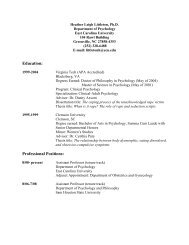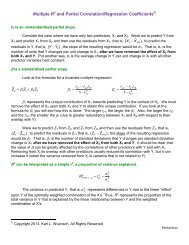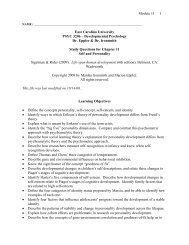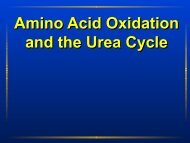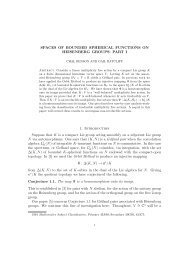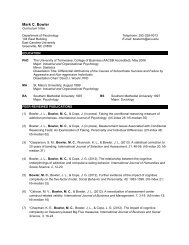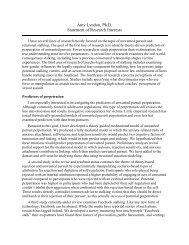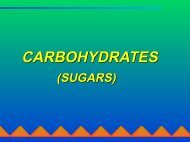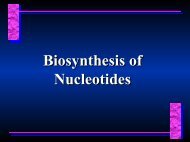Defining and Measuring Trophic Role Similarity in Food Webs Using ...
Defining and Measuring Trophic Role Similarity in Food Webs Using ...
Defining and Measuring Trophic Role Similarity in Food Webs Using ...
You also want an ePaper? Increase the reach of your titles
YUMPU automatically turns print PDFs into web optimized ePapers that Google loves.
DEFINITION OF TROPHIC ROLE SIMILARITY 307graph may have more than one regular equivalence.S<strong>in</strong>ce our goal is usually to seek thesimplest model, our discussion will center onthe maximal non-trivial regular equivalence (i.e.the one with the fewest equivalence classes).Consequently, when we write ‘‘regular equivalence’’it is understood that this means the maximalregular equivalence unless otherwise stated.An example of a regular equivalence is shown<strong>in</strong> Fig. 1(c), aga<strong>in</strong> us<strong>in</strong>g same color <strong>and</strong> fill to<strong>in</strong>dicate equivalence. To determ<strong>in</strong>e whether itis regular, we check each pair of nodes that iscolored the same aga<strong>in</strong>st the def<strong>in</strong>ition. Forexample, nodes 2 <strong>and</strong> 3 are colored the same,<strong>in</strong>dicat<strong>in</strong>g they are equivalent. Accord<strong>in</strong>g to thedef<strong>in</strong>ition, their out-neighborhoods (<strong>and</strong> their <strong>in</strong>neighborhoods)must conta<strong>in</strong> equivalent nodes(i.e. the same colors). Node 2 has <strong>in</strong>com<strong>in</strong>g tiesfromcross-hatched nodes <strong>and</strong> vertical-l<strong>in</strong>ednodes <strong>and</strong> no other colors. Node 3 is the same.Node 2 has outgo<strong>in</strong>g ties to stippled nodes <strong>and</strong>cross-hatched nodes. Node 3 is aga<strong>in</strong> the same(recall that the def<strong>in</strong>ition says noth<strong>in</strong>g about thenumber of nodes of each type that a node maybe connected to). Hence this pair satisfies thedef<strong>in</strong>ition. If all pairs do, the equivalence isregular. In contrast, Fig. 1(d) gives an exampleof a non-regular equivalence. One reason it isnot regular is that node 4 is colored the same asnode 2, yet node 4 has no tie to a vertical-l<strong>in</strong>ednode, while node 2 does.It is useful to note three desirable features ofregular equivalence. The first is that cycles, suchas the one connect<strong>in</strong>g nodes 2, 3 <strong>and</strong> 11 <strong>in</strong>Fig. 1(c), pose no difficulty. The second is thatomnivory also provides no particular problem,as nodes 10 <strong>and</strong> 1 feed at the same two levels ofthe food cha<strong>in</strong> (<strong>and</strong> are equivalent) whereasnodes 4 <strong>and</strong> 2 feed at different levels (<strong>and</strong> are notequivalent). The third is that two species can beregularly equivalent without hav<strong>in</strong>g any prey orpredators <strong>in</strong> common, as is the case with nodes 5<strong>and</strong> 6. Thus, regular equivalence captures theidea that species can occupy analogous positions<strong>in</strong> the food web, without the limitation found <strong>in</strong>the Yodzis–W<strong>in</strong>emiller approach that requiresspecies assigned to the same class to <strong>in</strong>teracttrophically with the very same species. Animplication of the last feature is that regularequivalence can be used to class together speciesthat are members of different food webs, yetoccupy analogous positions. An example is given<strong>in</strong> Fig. 1(e) <strong>in</strong> which nodes 12 <strong>and</strong> 2 are regularlyequivalent, yet obviously belong to separatewebs. In this way, regular equivalence may beused to improve upon the practice of compar<strong>in</strong>gwebs by count<strong>in</strong>g numbers of species by basal-,<strong>in</strong>termediate- <strong>and</strong> top-level species (Cohen &Newman, 1985).2.4. IMAGE GRAPHSThe image graph <strong>in</strong>duced by an equivalencerelation R on G is def<strong>in</strong>ed as the digraphG 0 (C(V),E 0 ) <strong>in</strong> which the nodes are the equivalenceclasses of R, <strong>and</strong> two nodes (i.e. classes) x<strong>and</strong> y are adjacent <strong>in</strong> G 0 if there exist adjacentnodes u <strong>and</strong> v <strong>in</strong> G such that C(u) ¼ x <strong>and</strong> C(v)¼ y [recall that C(u) denotes the equivalenceclass of node u]. In this sense, an equivalencerelation <strong>in</strong>duces a mapp<strong>in</strong>g, known as a graphhomomorphism, from the orig<strong>in</strong>al network to areduced model of the network. Figure 2(a) showsthe image graph for the structural equivalence <strong>in</strong>Fig. 1(a). It should be noted that <strong>in</strong> a structuralequivalence, the image graph is a completedescription of the entire systemof relations,Fig. 2. (a) Image graph for the structural coloration <strong>in</strong>Fig. 1(a); (b) image graph for the regular coloration <strong>in</strong>Fig. 1(c); (c) a graph of a hypothetical food web show<strong>in</strong>gthe regular equivalence of feed<strong>in</strong>g relations. Directed tiesare depicted by arrows that show the predator’s consumptionof a prey. Color codes are the same as <strong>in</strong> Fig. 1.



